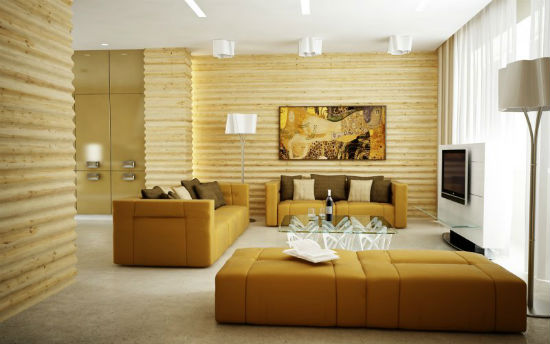Currently, there are certain rules for the sale of sawn timber, which consumers do not really like. All this happens due to the fact that when buying a product, not all buyers are able to correctly make calculations. Usually, a special table is used: how many lining in a cube have to be calculated very often during the acquisition process, because wood products, as a rule, are not calculated by weight or by the piece.
Number of units per cubic meter
To calculate the volume of products, there are some features in terms of measuring dimensions. However, the cubic capacity of any lumber is determined according to the same principle.
Wherein the variety and species of wood from which the product is made has no effect... When it is necessary to calculate how many pieces of lining in a cube, the calculation is carried out based on the working surface of the panel.
- The first step is to measure the length, useful width and thickness of one product. In our case, the dimensions of one product are: 16x15x6000 mm.
- Now you should find out the volume of the bar by multiplying these numbers. However, they must first be converted to meters. It turns out: 0.016 x 0.15 x 6 \u003d 0.0144 cbm m.
- Further, one cubic meter must be divided by the result obtained. Thus, the number of panels will be approximately 69,44 ... The last step is rounding.
Note! This is how it is calculated how many lining pieces are in a cube. However, unscrupulous sellers use some rounding tricks, so the price of the product rises slightly.
Number of squares per cubic meter
To purchase finishing material, you will need to find out what area of \u200b\u200bcoverage is contained in the cube. It can be completely different, because it all depends only on the thickness of the purchased products.
As for the quadrature, it helps to determine the area to be sheathed. That is, in the end, you can find out how many square meters of lining are in a cube.

- Measure the thickness of the coating. In the case of wood panels, it can be from 12 to 25 mm.
- It is necessary to translate this indicator from millimeters to meters, since the volume is measured in them. In the presence of sixteen-millimeter products, it turns out 0.016 m.
- Now you need to divide the cubic unit by the number that came out in the second paragraph. 1: 0.016 \u003d 62.5 squares.
Note! Having the simplest knowledge in mathematics, you can easily determine how much lining in 1 cube and how much facing material will be required for further work.
Calculation of material for finishing
The presented products are widely used for cladding indoor spaces and facades. Before starting work, preliminary calculations are required. They should be based on the most accurate measurements, and everything else is a matter of technology.

In the inner space
In the premises, the amount of required goods can be determined by dividing the total square into separate figures. Then only one plane is calculated, considered as a simple rectangle.
It is also advisable to measure the length of the segments, because wooden panels can be of different lengths, and this factor plays an important role.
- First of all, the length and width of the room are measured. Based on these indicators, the ceiling area is found, if it also needs to be sheathed with wood panels.
- Next, the area of \u200b\u200beach wall is calculated, for which the height and its length are determined. In most cases, opposite planes have the same area.
- As a result, all indicators add up to each other, regardless of the number of separate rooms. After that, the square of window and door openings is taken away, which is almost always reflected in the video.
Addition! It is advisable to add ten percent to the resulting figure, since it will not be possible to complete the work without waste in any scenario. Some scraps remain even when the length of the products is taken into account.
On the facade of the building
As for the calculation of the material for outdoor decoration, it is carried out in approximately the same way. However, the surfaces are usually much less marked. Doing it yourself, you can only face one difficulty, which will consist in finding the area of \u200b\u200bthe pediment.

First things first:
- The area of \u200b\u200bthe walls is calculated according to the same principle as inside. There are no differences.
- To determine the squaring of the gables, you need to multiply the height by the length of the base and divide by two.
- At the end, all the results are summed up, and the area of \u200b\u200bthe openings is subtracted from the resulting figure.
Note! It should be remembered that in the process installation works the longitudinal tenon fits into the groove of the adjacent strip. Therefore, when calculating, only the useful width needs to be considered.
additional information
Of course, you need to know how many boards are in the lining cube, but you also have to determine the number of cubic meters based on the number of square meters. This can be done by multiplying the total area by the thickness of the wood product.

Weight of goods depending on factors
To understand how much a lining cube weighs, you should first take into account the moisture content of the material, as well as the type of wood from which the products were made.
Below is a table to compare the metrics.
Finally
This instruction will help you make all the necessary calculations when purchasing wood panels. In this case, a special table is not required: how many lining boards in a cube you can find out on your own without any difficulties. However, when choosing, close attention will have to be paid to the quality of the product in order for the coating to be aesthetic.
The lining is so familiar and cute to the eye that every Russian man, like a gentleman who “remembers the date, but forgets about his age”, can close his eyes and easily remember her darling to the last bitch and burrs, but he will certainly forget the size. Bookmark this article to keep your tables close at hand.
Do you know?
In GOSTs there is no such term as "lining". Official documents operate with the term "sheathing" or "sheathing board".
And the widespread and more familiar to us name lining came from railway wagons with cladding from separate boards tightly adjacent to each other. The material with this type of connection came to the taste of artisans and therefore today is used for external and interior decoration everywhere.
Currently, the manufacture of this finishing material is regulated by the following standards: Russian standard GOST 8242-88 and German standard DIN 68-126 / 86, TU. The latter makes more stringent requirements for quality and grade.
How to decipher the manufacturer's inscription
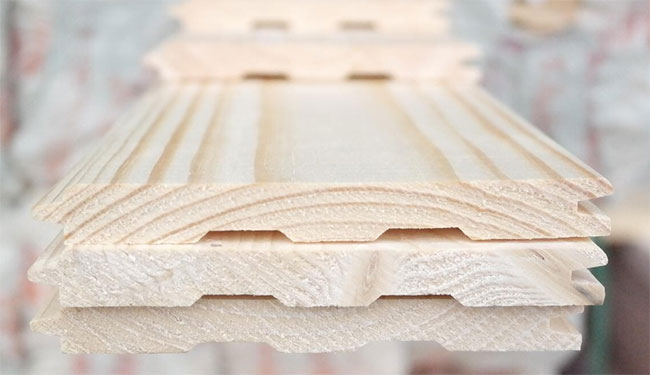
We read the marking as follows:
- Plating grade (see details below)
- Lining grade (see table below)
- ThicknessxWidthxLength
- Sometimes manufacturers indicate the number of pieces in a package
An example of a symbol for a euro lining:
Grade C 12.5x96 (88) x2000 mm 10pcs. in pack.
Euro lining of grade C, 12.5 mm thick, 96 mm thick, 2000 mm long. 10pcs in the package.
An example of a conventional lining according to GOST:
О-3-13x120x4000-GOST 8242-88
This means - Sheathing of grade O-3 with a thickness of 13 mm, a width of 120 mm, a length of 4000 mm is made according to GOST 8242-88.
Dimensions of standard lining according to GOST
Classic lining, in the common people "kolkhoz woman" is regulated by GOSTs with the name "sheathing board" of the following sizes and sections:
Lining brand O-1
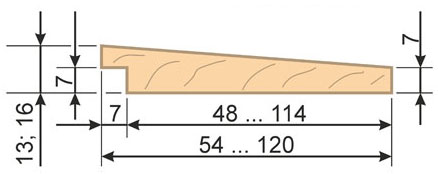

Lining brand O-2 (1st option)
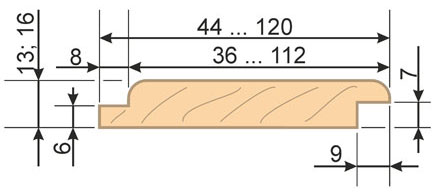

Lining brand O-2 (2nd option)
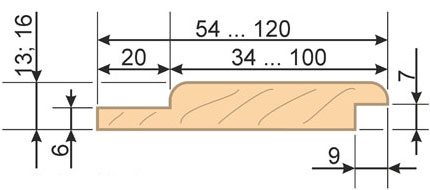

Lining brand O-3 (1st option)
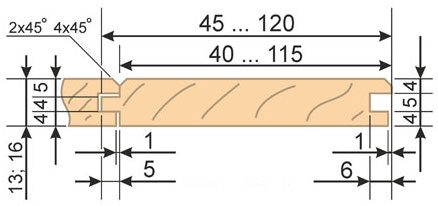

Lining brand O-3 (2nd option)


Lining brand O-4
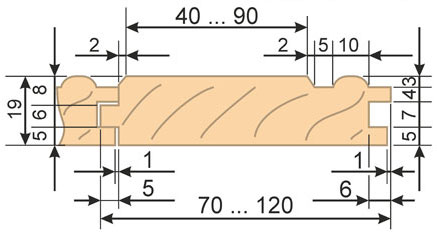

Made from wood different breeds: pine, spruce (conifers are the cheapest), birch, alder, linden, aspen, ash, oak, larch, cedar.
Evolution has taken the dimensions of the cladding board beyond the norms established by state standards, and today it is easy to find products of the following sizes on sale: thickness from 12 to 25 mm; width - up to 150 mm; length - up to 6000 mm.
Euro lining dimensions
Manufactured according to the Western European standard DIN 68126/86. The key difference from the domestic standard version discussed above is the presence of longitudinal ventilation slots (see the photo under this paragraph) on the back side, which work as compensators for stresses arising from changes in temperature and humidity, and also contribute to the drainage of condensate due to air circulation.
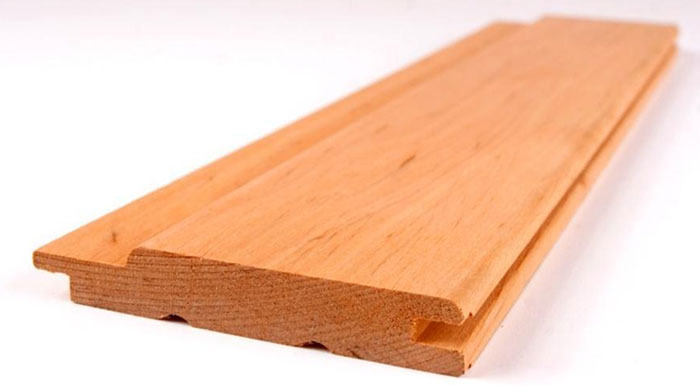
Dimensions according to European standards:
Thickness - 12.5-14-16-19-21 mm;
Width - 80-100-110-120-138 mm;
The thickness of the lining is calm for internal use - 12.5-16 mm,
For external - 18.5-22.5 mm.
Length graduation at the discretion of the manufacturer.
Packed in packs of 10.
Sizes of lining calm
Similar to euro lining, calm lining is made with longitudinal grooves on the back side.
Thickness - 12.5, 13.5, 14 mm
Width - 120, 140 mm
Length - 2-6 m.
Grades - A, B, C
Material - Pine
Humidity - 14%
Block house lining dimensions
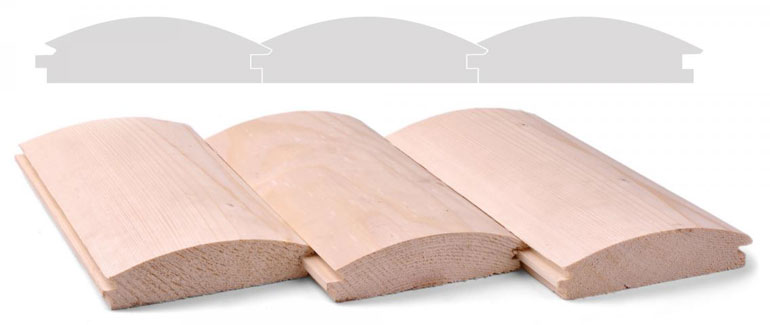
Lining MDF
This type of lining is made by pressing wood chips at a high temperature.
How not to burst when buying
If you buy material with a class lower than "Extra", and this is most likely the case, then it is necessary to lay the losses on the marriage, which will certainly be present closer to the middle of the pack.
Options:
1) Buy lining with a margin of 10-20%
2) Do not be too lazy to open the packaging upon receipt and demand replacement of the defective lining in accordance with the grade you paid: A, B, C.
How many lining are in a cube. A simple calculation method according to the formula of mathematics of the 5th grade
From my own experience, I can say that for household needs 1m3 of lining is enough for about 75-80m2, taking into account the cuts, it will turn out to sheathe about 70m2 of "usable area". Naturally, this dimensional guideline is very approximate and I recommend that you perform the necessary calculations yourself, taking into account your individual task.
Now you will see that it is very easy. Any search engine will kindly recall the formula for the volume of a rectangular parallelepiped from grade 5 mathematics:
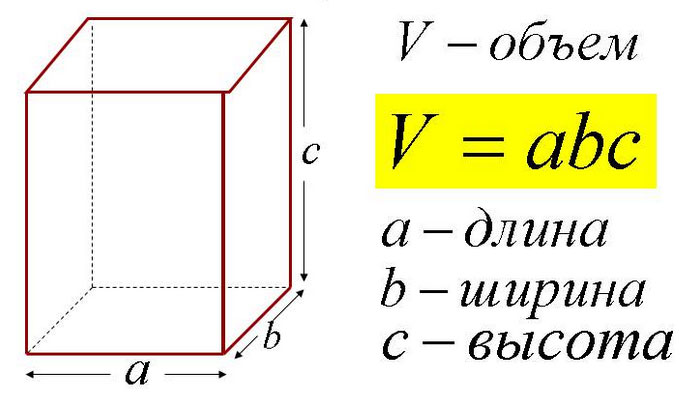
Let our lining have dimensions: Width 85
mm, Thickness 18 mm, Length 3m
We count the volume of one board V1 \u003d 0.018m * 0.085m * 3m \u003d 0.00459 m3 Quantity in one cube, pcs N \u003d 1 / 0.00459 \u003d 218 pcs
Attention: In the calculations we use the "useful" width of the lining, without taking into account the size of the tongue-and-groove connection, since the lining boards will be packed end-to-end.
To calculate the area that we can sheathe 1m3 of lining, we consider the area of \u200b\u200bone board S1 \u003d 0.085m * 3m \u003d 0.255 m2 We take the number of boards calculated above and multiply by the area of \u200b\u200bone board S \u003d 218 pcs * 0.255 m2 \u003d 56 m2
Subtract 10% for trim: 56 m2 - 6 m2 \u003d 50 m2
Total 1 cube board size 85 * 18 * 3000mm enough for wall cladding 50 m2.
Weight of one square meter of lining
Grade of wooden lining
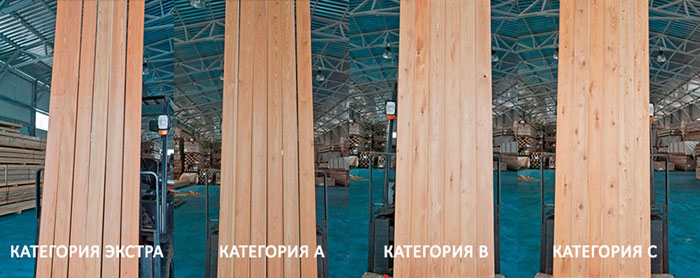
|
Vices |
Grade A |
Grade B |
Grade C |
|
Knots. Healthy light intergrown round, oval and oblong |
Allowed up to 1/3 of the product width |
any size allowed |
any size allowed |
|
Knots. Healthy of all kinds with cracks and shells |
Not allowed |
Allowed with cracks up to 1.0 mm and cavities up to 5 mm |
Allowed without restrictions |
|
Knots. Partially accrete |
Not allowed |
Allowed when growing at least 1/2 of the knot contour |
Allowed |
|
Knots. Non-fused dropping out as well as holes from dropped knots |
Not allowed |
Single knotted rib knots and minor damage on rib knots such as chipped edges are not allowed |
Allowed |
|
Knots. Rotten, rotten and tobacco |
Not allowed |
Not allowed |
allowed |
|
Knots. Partially fused stitched |
Not allowed |
Not allowed |
allowed |
|
Cracks. Seam blind |
Allowed with an outlet up to 100 mm in length |
Allowed no more than 1/3 of the product in length |
no limitation with a total length of no more than 80% of the product |
|
Cracks. Seam through without exit to the end and to the edge |
Not allowed |
Allowed no more than 1.0 mm wide and no more than 1/4 of the product in length |
No more than 5 pieces are allowed. per running meter |
|
Cracks. Plast through through with an exit to the end |
Shrinkage cracks with a length equal to the width of the board at each end are allowed |
Allowed no more than 150 mm in length from each end and no more than 1 mm thick |
Allowed up to 300 mm in length |
|
Core. With access to the face |
Allowed in places with a length of no more than 200 mm per linear meter |
Allowed |
Allowed |
|
Resin pockets. Open |
Not allowed |
Allowed to be no more than 50 mm long |
Allowed |
|
Resin pockets. Veiled |
Allowed up to 3x20mm in size, no more than 2x per running meter |
Allowed |
Allowed |
Attention
On sale comes material with an "intermediate" designation "AB". This nuance can be interpreted as a lining of class "A" with the presence of an element of class "B".
Dear site visitors, please send any wishes, inaccuracies noticed, recommendations, criticism to the mail: [email protected]website
It is usually measured in square meters, since it is sheathed with walls and ceilings, i.e. flat surfaces. To find out the surface area (P), it is necessary to multiply the length (L) by the width (W).
The first what to do when calculating the total area of \u200b\u200bthe order lining - split the entire area of \u200b\u200bthe walls and ceiling into rectangles. Usually, if it is necessary to calculate one wall or ceiling, then one rectangle is considered, but this does not happen often.
The second is very important for a good calculation of the lining - find out how long the lining segments will be. Since the lining is produced in different lengths and the price varies from length, this can significantly affect the cost of the order.
- The cost will depend on two factors:
- The smaller the segments, the lower their price
- The less waste (unused sections), the less lining itself is needed
Therefore, it is best to indicate the exact length of the lining and its quantity when ordering. For example, 25 m2 for 1m, 6 m2 for 2.5 and 3 m2 for 4m. This will result in three different orders, possibly with different prices per m2.
Since usually the most diverse, often difficult surfaces are sheathed with clapboard, the main task of correct calculations is correct measurements, the rest is a matter of technology. Once again, carefully double-check the number and size of the rectangles, write down their length and width, and proceed with the calculations.
Third and obligatory what you need to do before starting the calculations is to convert mm and cm to meters. This can be done according to the table below. So:
Calculation of the area of \u200b\u200bthe lining
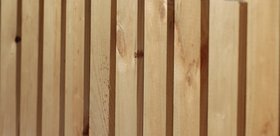 Calculation of the area of \u200b\u200bone wall:
Calculation of the area of \u200b\u200bone wall:
P \u003d LxW,
where P is the area, D is the length, W is the width.
For example, a wall 2m by 3m,
P \u003d LxW\u003d 2x3 \u003d 6 m2
To find out order value (S-order) , it is necessary to multiply the area of \u200b\u200bthe order (Order) by the cost (C) of one square meter.
Order \u003d Order,
if there are more than one rectangles with a length of approximately the same lining length, all areas must be added:
Order \u003d L1xW1 + L2xW2 + L3xW3 ... + DNxSHN,
where Order - the area of \u200b\u200bthe order, D1, D2, D3 ... DN - respectively, the lengths of the first, second and third rectangles, Ш1, Ш2, Ш3 ... ШN - respectively, the widths of the first, second and third rectangles.
For example, one rectangle is 1 by 4, another 2x2.5 and the third 2x3,
Order \u003d L1xSH1 + L2xSH2 + L3xSH3\u003d 1x4 + 2x2.5 + 2x3 \u003d 15 m2
Calculation of the lining area for a known number of running meters
For example, you need to buy a certain number of running meters or a certain number of boards (planks) lining... How to calculate their area (Order) and find out the cost of the order (Order):
We calculate the area of \u200b\u200bthe order (Order). The area is equal to the product of the width and the length (the length is multiplied by the width). Known to us running meters and make up the length (PM) \u003d (D), and the width of the lining is the width (SH) \u003d (W).
Order \u003d LxW \u003d PMxShD,
where Order - the area of \u200b\u200bthe order, PM - running meters, ШД - board width,
Order \u003d Order,
where Сorder is the cost of the order, С is the cost per square meter of lining.
For example, you need 40 running meters of lining 80mm wide and 14mm thick,
We translate the width into meters 80mm \u003d 0.08m
Order \u003d PMhShD\u003d 40x0.08 \u003d 3.2 m2
The cost of a square meter of 14mm thick lining is 42 UAH / m2
Order \u003d Orders\u003d 3.2x42 \u003d 135 UAH.
If a the number of boards of a certain length and width of the board are known (ШД), then the miscalculations are similar, except that running meters (LM) is the number of boards (CD) multiplied by the length of the board (DD).
Order \u003d LxW \u003d KDxDxShD,
where Order is the area of \u200b\u200bthe order, KD is the number of boards, DD is the length of the board, SH is the width of the board
For example, we need 25 boards 4 meters long, the width of the boards is 80mm.
We translate the width of the boards into meters. 80mm \u003d 0.08m
Order \u003d KDxDDxShD\u003d 25x4x0.08 \u003d 8 m2
Calculation of the number of lining with a known order area
 If you know the area of \u200b\u200bthe order and need to calculate the number of boards
(КД), then it is necessary to divide the area of \u200b\u200bthe order (Order) by the width of the board (ШД) and the length of the boards (ДД)
If you know the area of \u200b\u200bthe order and need to calculate the number of boards
(КД), then it is necessary to divide the area of \u200b\u200bthe order (Order) by the width of the board (ШД) and the length of the boards (ДД)
PM \u003d Order / SD,
KD \u003d PM / DD,
where КД - the number of boards, Ordering - the area of \u200b\u200bthe order, ШД - width of the board, PM - running meters, ДД - length of the board
Example: How many boards 70mm wide and 4.5m long will be needed for 40m2 floor?
We translate the width of the boards into meters. 70mm \u003d 0.07m
PM \u003d Order / SD\u003d 40 / 0.07 \u003d 280 running meters
CD \u003d PM / DD\u003d 280 / 4.5 \u003d 63 boards.
The volume and weight of the lining
Order \u003d OrderTD,
where Order is the volume of the order, TD is the thickness of the board (in meters).
In order \u003d In order,
where In the order is the weight of the order, B is the weight of one square meter.
Another example: what will be the volume of 400m2 of pine lining 100mm wide and 15mm thick? This information may be needed when choosing the type of vehicle for delivery.
We translate the thickness into meters. 15mm \u003d 0.015mm
Order \u003d TD\u003d 400x0.015 \u003d 6 m3. We find out from the table that the weight of pine lining is approximately 6.5 kg. Order \u003d Orders in\u003d 400x6.5 \u003d 2600 kg \u003d 2.6 tons.
If you still have questions or something does not work out - call us, we will help.
| mm | cm | m |
|---|---|---|
| 10 | 1 | 0,010 |
| 12 | 1,2 | 0,012 |
| 14 | 1,4 | 0,014 |
| 15 | 1,5 | 0,015 |
| 20 | 2,0 | 0,020 |
| 60 | 6 | 0,060 |
| 65 | 6,5 | 0,065 |
| 70 | 7 | 0,070 |
| 75 | 7,5 | 0,075 |
| 80 | 8 | 0,080 |
| 100 | 10 | 0,100 |
| 105 | 10,5 | 0,105 |
| 120 | 12 | 0,120 |
Before starting work on sheathing or finishing a room, it is necessary to calculate the material. This is done both in order to save money without overpaying for surpluses, and in order to calculate the weight that will put pressure on a particular area of \u200b\u200bthe room. Since we are talking about covering the area, it is more convenient to calculate the lining in square meters.
Calculation of the specific gravity of wooden lining
Lining is a layer of natural wood that can be easily mounted without the slightest gaps. The thickness of an individual lining panel is 12-15 mm on average. In some cases, the thickness can be up to 20 mm when exterior finishing work is planned. This indicator is important both when calculating the volume and when calculating the weight of the material. The useful width of the wooden lining is 80-88 mm, and sometimes 190 mm. The length is 2-3 m, although there is also a 6-meter lining.
Wooden lining is made from different types of wood, which also affects the estimated weight and cost of this material. For example, a square meter of poplar will weigh 5.7 kg, and a meter of ash - 11 kg.
- Divide 1,000,000 by the length of the bar in meters;
- Divide the resulting size by the thickness of the timber in mm;
- Divide by the width of the bar in mm.
What else to consider when calculating?
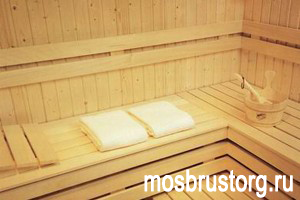
Although the formula itself gives the correct direction to the calculations, still calculating how much it weighs wooden lining there are other factors to consider. For example, the key point is the moisture content of the wood. It is no secret that a wet tree weighs much more than the same species that has been thoroughly dried or stored in dry ideal conditions.
In this case, it is worth considering what kind of wood we are talking about, because different wood absorbs moisture in different ways and dries out at different rates. This means that if you buy ready-made lining from poorly drying wood, then you should make sure that it has gone through the necessary drying processes. Only then will she be able to delight you with her beauty and will not give any defects later.
Skillful calculation of the lining weight is the key to successful finishing and decoration of any room.
Gallery
Video
Before starting work on sheathing a room or external walls, it is required to calculate the amount of material required. This is done in order not to buy it more than the required footage, or vice versa, so that it does not turn out to be too little. To begin with, a plan is drawn up and it is determined how to calculate the number of lining.
Clapboard is mainly used for sheathing flat surfaces. Therefore, to calculate the required amount material use such an indicator as square meters.
Lining is delivered in bulk, without packaging, or in a shrink-wrap package with mandatory marking.
Standard dimensions of wooden lining (width, length and thickness), as well as its weight
The lining is a thin layer of natural wood. It is easy to install without leaving any gaps. The surface finished with its help has a wonderful appearance. The thickness of the lining varies from 12 to 15mm, sometimes this size reaches 20mm (such boards are used for exterior decoration). This is quite enough so as not to break or push through the installed lining. This size should be taken into account when calculating the required volume of material.
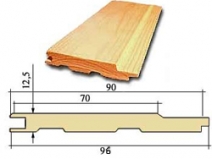
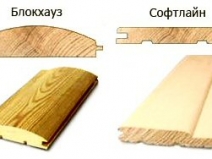
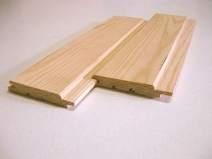
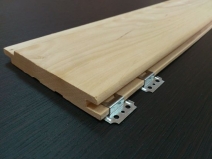
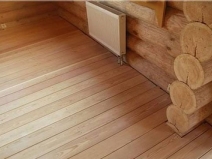
The calculation of the cost directly depends on the material from which the finishing element is made and on its thickness. The standard length of the board is 2-3 meters, but sometimes you can find six-meter elements. When calculating the number of units of production, you need to pay attention to the useful width of the lining. Usually it is 80 or 88mm. But sometimes this size reaches 190mm. Such an indicator is wide for the lining.
The finishing material produced from various types of wood. The better it is, the less waste will be obtained when performing work. Therefore, when choosing and calculating a board, you need to make sure that its appearance meets certain requirements for the corresponding tree species and grade.
When calculating the material, the weight of the lining should also be taken into account. It directly depends on the wood used. One square meter of poplar, for example, weighs 5.7 kg, and ash - 11 kg.
Calculation of lining for finishing work: how many pieces are in one cube, and how to find out the required number of boards
For a correct calculation, you should measure such quantities as the length, width and height of the room where the finishing work... Multiplying the last two indicators, you get the required square meters.
If the surface to be sheathed has the wrong rectangular shape, then the surface of the walls or ceiling is divided into separate triangles and the area of \u200b\u200beach section is calculated. The results are then summarized.
It is quite easy to calculate the required volume of the lining. For this, the calculated area is multiplied by the thickness of the board. To find out how many pieces of lining are in a cube, you need to decide on such parameters as the length, thickness and width of each element. These three indicators are multiplied, and then 1m3 is divided by this number. Thus, the number of boards per cubic meter is obtained.
It should be noted that an accurate calculation involves the use of trim parts without any residues, which is impossible in real life. Therefore, the result obtained in the calculation is increased by 15% in case of unforeseen situations (marriage, defects, etc.).
More about the dimensions and calculation of the number of lining
Lining comes in different sizes, how to calculate how many boards are in pieces and in square meters in a cube?
The calculation of the number of lining in a cube does not depend in any way on the type and type of wood. The dimensions of the board are important here. So, we are interested in the length, width and thickness of one whip.
Example: We have a board 160 * 22 * \u200b\u200b3000 mm. We translate into meters, calculate the volume of one plate V \u003d LxDxH, so V \u003d 0.16x0.022X3 \u003d 0.01056 m 3. This amount should not be rounded off, since in large quantities significant errors are obtained.
Now we calculate how many boards are in a cube, divide 1 by the resulting volume: 1: 0.01056 \u003d 94.7, so we get 94 whole boards and another piece of about 2 m.
To calculate how many square meters in a cube, you need to calculate the area of \u200b\u200b1 board, S \u003d DxL, multiply the length by the width: 0.16 * 3 \u003d 0.48 m 2. Above, we have already calculated that we have 94.7 boards in a cube, 0.48x94.7 \u003d 45.45 m 2 in a cube. Another way, you need to divide 1 cube by the thickness of the board, in our case: 1: 0.022 \u003d 45.45 m 2.
But we should not forget that not all of the lining area is useful. 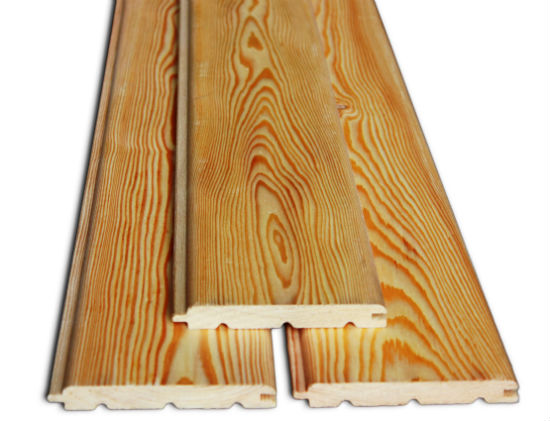
What are the dimensions of the lining to consider in order to determine the useful area of \u200b\u200bthe board?
The general dimensions of the wooden lining are regulated by the specifications of the manufacturers. But in order to calculate the useful area, you should pay attention to the shape of the board, we are interested in a thorn. So, if the width of the lining is 160 mm, and the spike is 8 mm, then the working part is 160-8 \u003d 152 mm.
Let's take the dimensions as an example: a lining with a length of 3 m, its useful width is 0.152 m. We calculate the useful area of \u200b\u200bone board: 3x0.152 \u003d 0.456 m 2.
As for the length of the board, then there are also nuances in calculating the usable area. The higher the grade of the lining, the less scraps, and if you buy premium material, then no more than 0.1% will be spent on the sawn-off, and when using a low quality board, the cost of which is lower, the waste will be 10 percent or more, and in fact, the price the lining will be the same, if not cheaper. 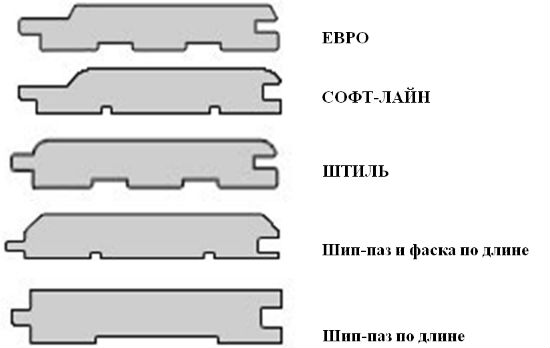
What is the thickness of the wooden lining, where and which one is better to use?
The thickness of the lining is regulated by GOST for domestic producers, according to which the thinnest board is 12 mm or more, but not thicker than 25 mm. Stricter rules are provided by DIN for euro lining made of wood, the thickness of the die can be 19, 16 and 13 mm.
We emphasize that boards with a thickness of 12 to 16 mm are recommended to be used for sheathing of interiors, exterior decoration is carried out with thicker boards. The thinner the board, the closer the lathing bars should be to each other, the average distance is 300-500 mm. For fixing 12 mm dies on the ceiling, there can be just a crate, but the wall must be sheathed with plywood, and only the lining can be attached to it, if this is not done, the slats are simply squeezed through from minor mechanical influences. 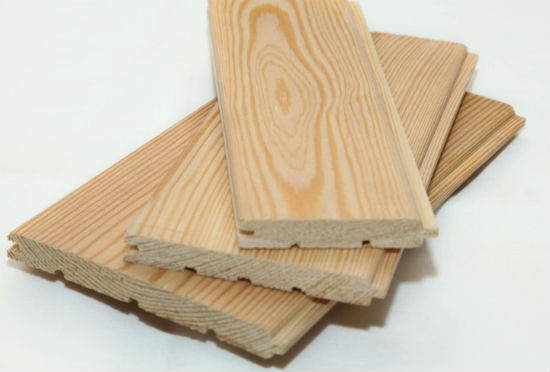
How to correctly calculate how many packages are in a cubic meter, and what area can be sheathed with a pack of lining?
We will take as a basis standard sizes Euro lining: 96 mm overall width, 88 mm working width, 12.5 mm thickness, 6000 mm length. We calculate the useful area of \u200b\u200b1 whip: 0.088x6 \u003d 0.528 m2. One pack - 10 pieces, so that the amount of material can be sheathed: 0.528x10 \u003d 5.28 m 2.
To understand how many lining are in the package, you should find the net volume: 0.096x6x0.0125 (die thickness in m) x10 quantity in a pack \u003d 0.072 m 3. Thus, in one cubic meter: 1: 0.072 \u003d 13.89 packages.
And we already know that 5.28 m can be finished with one package, therefore, one cubic meter is enough to sheathe 13.89x5.28 \u003d approximately 73 sq. 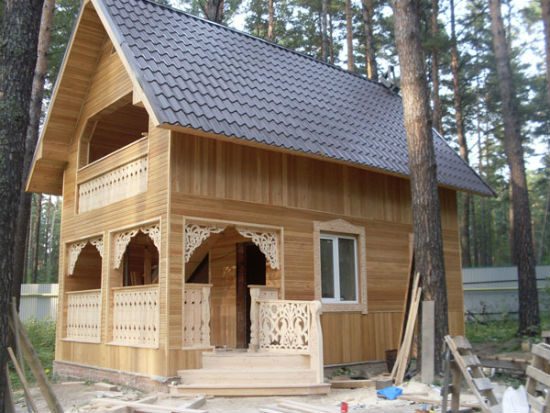
What role does the length of the lining play, how to choose the right board of the required length?
The standard length of the lining is 2, 3 and 6 m, according to the European standard it can also be 0.5 m. From practice we can say that the most convenient length is 3 m, such material is easy to transport and store. A 6 m board is suitable for finishing long rooms, for example, a 5.8 m loggia, you can buy a 3 meter whip, but then you have to make a joint.
Often, the walls are sheathed indoors and the lining is laid vertically, here it is advisable to use whips of 3 m.But when calculating, it should also be borne in mind that the ceiling height is approximately 2.5 - 2.7 m, significant trimming remains, more than 10% of the total volume. If you need to save money, it is recommended to buy a docking element and 2-meter strips, you can dock the lining with a diagonal or checkerboard pattern. 
What does the width of the lining matter?
Today on the market there is a huge range of profiled strips, their width ranges from 80 to 200 mm. It is very important to pay attention to the ratio of the width and thickness of the whips, as the best physical and mechanical characteristics of the material, whose parameters correspond to the proportion of 1: 6. For example, the width of a wooden lining is 150 mm, which means that its optimal thickness is 150: 6 \u003d 25 mm.
It should be noted that the thickness of the planks also affects the aesthetics of the room. For large rooms it is better to buy wide slats, and vice versa. But if the goal is to visually raise the ceiling, then you need to use narrow whips, and fasten them vertically.
It is better if the useful width of the lining is a multiple of the height of the room, if the sheathing is horizontal, and the width, if the room will be sheathed vertically, so there is no need to adjust the last plank. 